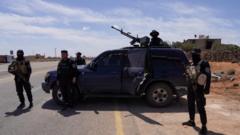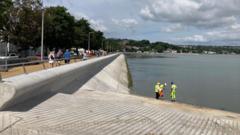What Sparked the Deadly Sectarian Clashes in Syria That Left 30 Dead?

Understanding the Recent Clashes in Southern Syria: Causes, Implications, and Future Prospects
The recent violence in southern Syria has resulted in tragic fatalities, with reports indicating that at least 30 people have lost their lives due to clashes between Bedouin Sunni tribes and fighters from the Druze religious minority in the city of Sweida. The situation has drawn the attention of both local authorities and international observers, as it underscores the ongoing fragility of Syria’s social fabric and political landscape. In this article, we will explore the causes of these clashes, the implications for the region, and what the future may hold for Syria as it navigates its complex sectarian tensions.
The Background: A Brief Overview of the Syrian Civil War
To fully comprehend the recent events in Sweida, it's essential to revisit the backdrop of the Syrian Civil War, which began in 2011. The conflict arose from a mix of political dissent against President Bashar al-Assad's regime, socio-economic grievances, and the desire for greater freedoms. The war has since spiraled into a multifaceted crisis involving various factions, including the Assad regime, rebel groups, and extremist entities.
The Role of Minority Groups
Syria is characterized by a rich tapestry of ethnic and religious minorities. The Druze community, which is an offshoot of Shia Islam, has historically maintained a cautious relationship with the Assad regime. Many Druze individuals were loyal to the state during the civil war, hoping that the regime would provide protection against extremist factions. In contrast, the Bedouin Sunni tribes have often found themselves at odds with the government, aligning more closely with opposition forces.
Recent Clashes in Sweida
The recent clashes in Sweida can be attributed to a complex interplay of historical grievances, resource competition, and the power vacuum left by the Assad regime's weakening control. Following the fall of the Assad regime in December, a new Islamic-led government emerged, further complicating the already fractured relations among various groups.
The Immediate Triggers
Several key factors have contributed to the escalation of violence in Sweida:
- Resource Scarcity: Competition for resources, including water and land, has intensified tensions between Bedouin Sunni tribes and the Druze community.
- Political Vacuum: The collapse of the Assad regime has left a power vacuum that various groups are eager to fill, leading to clashes as factions vie for control.
- External Influences: The involvement of regional powers and international actors has complicated the situation, as different factions receive varying levels of support.
The Human Cost of the Clashes
The human toll of these conflicts is staggering. Reports indicate that at least 30 people have lost their lives, with the Syrian Observatory for Human Rights putting the death toll at 37. Additionally, around 100 individuals have been injured in the violence. The interior ministry has committed to intervening directly to restore order, highlighting the urgency of the situation.
Calls for Restraint
In response to the violence, local leaders, including the governor of Sweida, Mustapha al-Bakur, have urged residents to exercise self-restraint and respond to national calls for reform. Spiritual leaders from various communities have also called for calm, emphasizing the need for dialogue over conflict.
The Broader Implications of the Violence
The ongoing clashes in Sweida extend beyond local skirmishes; they represent a potential flashpoint for wider conflict in Syria. The fragility of the social fabric, characterized by deep-rooted sectarian divisions, poses significant risks for the future stability of the region.
Potential Consequences
Several potential consequences could arise from the recent violence:
- Escalation of Sectarian Violence: Ongoing clashes could lead to further sectarian violence, destabilizing the region and prompting retaliation from affected communities.
- Weakening of Governance: The inability of the new Islamic-led government to maintain control may lead to a breakdown of law and order, resulting in a worsening humanitarian crisis.
- International Response: The international community may feel compelled to intervene, whether through diplomatic means or humanitarian aid, to prevent further escalation.
What Lies Ahead for Syria?
The future of Syria remains uncertain, especially in light of recent developments. As various factions push for control, the potential for renewed conflict looms large. The international community’s recent efforts to reset relations with Syria indicate a shifting landscape, but the underlying issues remain unresolved.
Rebuilding Trust Among Communities
For Syria to achieve lasting peace, rebuilding trust among its diverse communities is essential. This can only be accomplished through open dialogue, reconciliation efforts, and a commitment to inclusive governance. Without these measures, the cycle of violence is likely to continue.
Conclusion
The clashes in Sweida serve as a stark reminder of the fragility of Syria’s social and political landscape. As the situation continues to evolve, the focus must remain on preventing further violence and fostering a sense of unity among the country’s diverse communities. Only through collective efforts can Syria hope to emerge from its protracted crisis and work towards a more stable and peaceful future.
FAQs
What sparked the recent clashes in Sweida, Syria?
The clashes were primarily triggered by competition for resources, historical grievances, and the power vacuum left by the collapse of the Assad regime.
What is the current death toll from the violence?
Reports indicate that at least 30 people have been killed, with some estimates suggesting the number could be as high as 37.
How are local leaders responding to the violence?
Local leaders, including the governor of Sweida, have called for self-restraint and dialogue among communities to resolve tensions.
What are the implications of these clashes for Syria's future?
The ongoing violence could lead to further sectarian conflict, a weakening of governmental authority, and potential international intervention.
As the situation in Syria continues to evolve, how do you think community leaders can effectively foster dialogue and peace among different groups? #SyriaConflict #Peacebuilding #MiddleEastTensions
Published: 2025-07-14 04:31:45 | Category: technology



